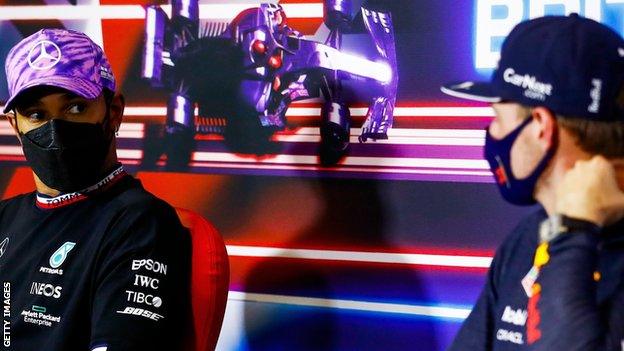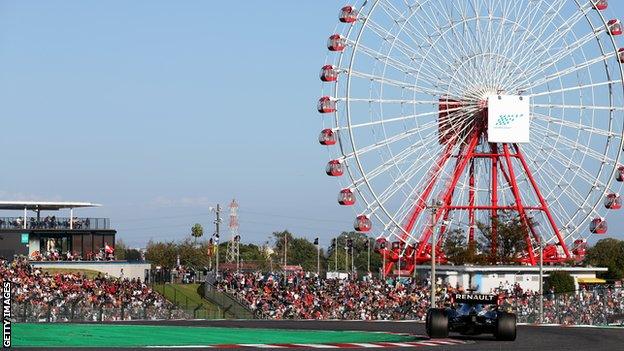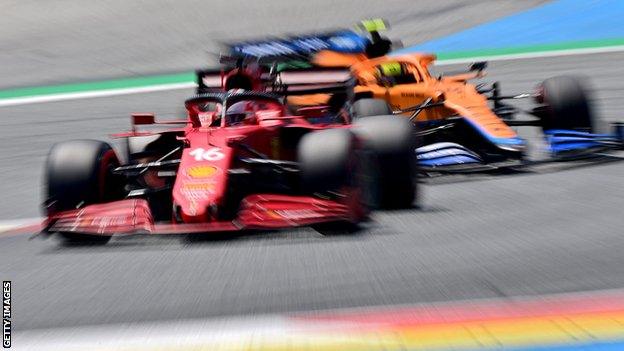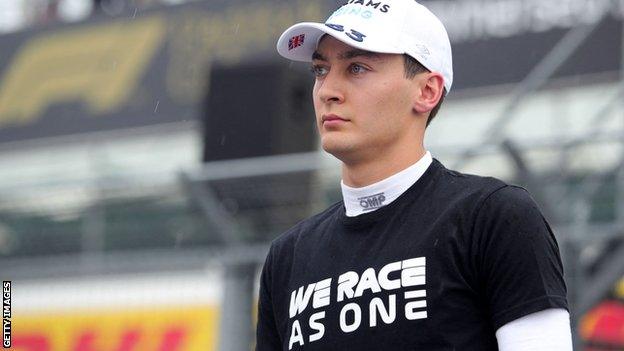Lewis Hamilton v Max Verstappen: Uncertainty hangs over intense Formula 1 title fight
- Published
- comments

Radio and text coverage of the Belgian Grand Prix is live on the BBC Sport website
The Formula 1 season restarts at the Belgian Grand Prix this weekend with the title fight finely poised and an air of uncertainty hanging over the second half of the championship on many different levels.
Lewis Hamilton and Max Verstappen are locked together in one of the most intense and bitter campaigns for years, their Mercedes and Red Bull teams slugging it out both on and off the track with no quarter asked or given.
But how long will their contest last? The Japanese Grand Prix was cancelled last week, and no-one knows for sure exactly how many races there will be before the end of the season.
Between now and then, Hamilton v Verstappen is just one of a number of intriguing narratives set to unfold.
The slugfest
The magnificent Spa-Francorchamps circuit in the Ardennes forests starts a run of three races on consecutive weekends on legendary European tracks.
After Belgium, the return of F1 to Zandvoort in the Netherlands for the first time since 1985 promises a febrile, intimidating atmosphere packed with passionate Verstappen fans, and it is followed by the Italian Grand Prix at charismatic Monza.
Hamilton starts this run of races with an eight-point championship lead. But while that might suggest at first glance that he is a narrow favourite for a record eighth title, a closer analysis of the season so far belies that belief.
Traditionally, the second half of the season is when Hamilton really comes alive. In the past, both his ex-Mercedes team-mate Nico Rosberg and former Ferrari driver Sebastian Vettel were steamrollered through late summer and autumn as Hamilton hit a rich vein of consistency and form in the 2014, 2015, 2017 and 2018 seasons.
That may yet happen again. But 2021 has been Mercedes' toughest season since the start of the hybrid era in 2014.
Just two races ago, Verstappen had moved into a 32-point championship lead with four victories in five races. He'd have won all five had he not suffered a tyre failure at the end of the Azerbaijan Grand Prix, which was won by his team-mate Sergio Perez, and Hamilton seemed to be on the ropes.
Then came the crash between Hamilton and Verstappen at the British Grand Prix - a key turning point as Verstappen retired and Hamilton went on to win. That was followed by another difficult weekend for Verstappen in Hungary, when his car was badly damaged in the first-corner pile-up triggered by a mistake from Mercedes driver Valtteri Bottas, and he could finish only ninth, while Hamilton was third.
The arguments as to who was to blame - and to what extent - for the incident at Silverstone will rage for as long as people are interested in motor racing.
But regardless of the rights and wrongs of that situation, the cumulative effect of both races is two-fold - firstly, that Hamilton has enjoyed a 40-point swing in his favour in the championship; and secondly that there has been no real chance to judge the respective race pace of the two cars since Mercedes introduced an upgrade in Silverstone.
Before Silverstone, Red Bull clearly had a pace advantage over the two races in Austria. Mercedes could and should have won the race before that in France, but their car had been faster over one lap in qualifying than the Red Bull only once in five races. Following the upgrade, Hamilton qualified fastest at both Silverstone and Hungary.
Mercedes appeared, then, to have eked out a small advantage again, but how the competitive picture will play out between the two teams over the rest of the season is unknown.
Adding further uncertainty is the situation surrounding Verstappen's engine allocation.
Red Bull's partner Honda had hoped to salvage the engine that was in the car at Silverstone - which was the second of Verstappen's permitted three power-units this season.
But in Hungary Honda discovered a previously unseen crack and had to replace it, and Verstappen had to take his third and final engine.
Can the second engine be salvaged? For now, Honda is not saying. If not, the chances of Verstappen requiring a fourth engine to make it to the end of the season are high - and that would mean a grid penalty somewhere down the line, a further blow in his title campaign.

The Tokyo Olympics went ahead, but the Japanese government decided to cancel the country's grand prix
Uncertainly over the calendar
The cancellation of Japan for the second year in a row because of the pandemic leaves 10 races officially on the calendar between now and the end of the season.
But that's unlikely to be the way it stays. F1 president Stefano Domenicali has been steadfast in his determination to run as close as he can to a record 23-race season despite the challenges of the pandemic, which has already seen the events in Australia, China, Canada and Singapore also called off.
F1 has been spending the summer break - when all teams are required to shut down for two weeks to give staff time to rest and recuperate - working out how the final part of the season could look.
There are a number of uncertainties, and the picture is complicated by global travel restrictions. For example, Turkey, Mexico and Brazil are currently on the UK's red list requiring 10 days of hotel quarantine for anyone returning from those countries, and as most teams are based in the UK, that matters.
The cancellation of Japan raises problems with the Turkish event - the plan had been for UK-based staff to run out their 10-day quarantine period from Istanbul in Suzuka, but that has gone by the wayside.
A second race in Austin, Texas, a week before the US Grand Prix, had been mooted. But that now looks unlikely to happen.
The period around October and November is particularly thorny - currently it is Turkey followed by a three-week gap left by Japan, then the USA, Mexico and Brazil. But there is likely to be some shuffling around, and it is set to be another couple of weeks or so before the detail of the calendar around that period is finalised.
The end of the season looks clearer. A new event in Qatar is expected to be added to make it a three-race finale in the Middle East, with the season culminating with the new race in Jeddah in Saudi Arabia and the last event in Abu Dhabi.
Even then, the Brazil issue means it remains to be seen whether that is three weeks in a row, or whether Qatar has to be straight after Brazil to avoid the UK quarantine, and then a gap before the final two races.

Ferrari and McLaren once battled for the F1 constructors' title, but they are far behind Mercedes and Red Bull in 2021
Ferrari v McLaren, and the Ricciardo problem
Behind the title fight, there is an equally intriguing fight for third between Ferrari and McLaren, who are tied on points behind Mercedes and Red Bull, with Ferrari classified ahead on results count-back.
A glance at the drivers' championship table underlines McLaren's problem in this fight, though. While Lando Norris - one of the stand-out stars of the season - is in a brilliant third place behind Hamilton and Verstappen, his McLaren team-mate Daniel Ricciardo is 63 points behind the Briton in ninth place.
Ferrari drivers Carlos Sainz and Charles Leclerc, meanwhile, are just three points apart in sixth and seventh places.
Sainz has had an impressive debut season for Ferrari, but even so Leclerc has been the team's stronger driver, and should be higher up - luck has not gone his way.
But the closeness of the Ferrari drivers merely serves to emphasise the struggles being suffered by Ricciardo, who is taking an unexpectedly long time to adapt to the driving style required by the McLaren car, a situation being exacerbated by Norris' consistent excellence. To be third in the championship ahead of both second drivers for the top two teams is a quite outstanding performance.
Regularly out-paced by Norris, sometimes to a considerable degree, Ricciardo's frustration has been mounting, and recently he described his plight as "a bit of a sad reality for the moment".
That sounds a notably pessimistic assessment for someone not only known for his positivity, but who has also established himself over the last few years as one of the leading drivers in the sport.
Ricciardo's problem stems from a mis-match between the way he drives and the way the McLaren needs to be driven.
Ricciardo, McLaren's performance director Andrea Stella says, "likes to roll the speed into the corner and not necessarily attack the braking as much as our car requires".
The McLaren is strong in the straight-line part of the braking phase, but relatively weak on turn-in, which makes Ricciardo's style a poor fit for it, and he is struggling to generate the necessary degree of rotation on corner entry.
The surprise, though, is the time it is taking him to adapt, which is not what would be expected of a driver of his calibre.
Will the summer break have given him a chance to reset, clear his mind and come back stronger, or is he stuck with this to the end of the season? The answer could well determine McLaren's chances of beating Ferrari to that coveted third position.

Russell excelled when he filled in for Lewis Hamilton for one race at Mercedes last season
The driver market
Off-track, the biggest questions surround who drives where next season.
The key decision still unannounced is who will get the second Mercedes seat alongside Lewis Hamilton, who last month committed to a further two years with the team.
The decision, team boss Toto Wolff has made clear, is between incumbent Valtteri Bottas and Williams driver George Russell, and the Briton is widely expected to get the nod, having more than proved his potential as a future superstar over the last couple of seasons.
Some insiders believe a decision has already been made in Russell's favour, but Mercedes say nothing will be finalised until next month.
If Russell does get the seat, Bottas is looking at a move either to Alfa Romeo - probably in place of Kimi Raikkonen, whose illustrious F1 career looks as if it might be coming to an end after a lacklustre first half of the season and with his 42nd birthday looming in October - or back to Williams in a swap with Russell.
Outside Mercedes, will Perez keep the second Red Bull seat? The Mexican has impressed on occasion, and is slightly closer on average qualifying pace to Verstappen than either of his predecessors, Alex Albon and Pierre Gasly. But he is fifth in the championship, and has only rarely performed the role of spoiler to Mercedes that Red Bull require from their second driver.
Further down the grid, the line-ups at Ferrari, McLaren and Aston Martin will continue as they are, and Alpine is all but confirmed.
Hungary winner Esteban Ocon already has a new three-year deal and Alpine have strongly hinted they will take up their option on Fernando Alonso, whose performances have been extremely impressive since he became fully familiar with his new car in the early summer.
But all other teams have some degree of uncertainty over them.
Outside the driver market, there are some big decisions to be made by F1 bosses, especially on the details of the new engine formula that will come into force from 2025.
The plan is for an increase of the proportion of performance provided by the hybrid part of the engine to 50% of the total power output, and the introduction of fully sustainable fuels. But the architecture of the engine - specifically whether it has an MGU-H, the part of the hybrid system that recovers energy from the turbo - and the detail of the fuel, whether it will be bio-fuel or synthetic e-fuel, are undecided.
There is a big meeting of engine manufacturers with the FIA planned for the Italian Grand Prix after which more clarity may emerge.

The ultimate Jay Z playlist: An hour of music from the 23-time Grammy winner
Bloodsport: Listen to the story of a systematic Olympics doping scandal

